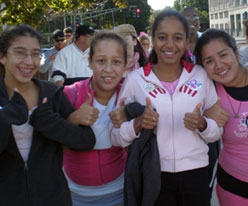Be Safe

BE SAFE is a collaborative prevention initiative that focuses on youth and the interconnected issues of mental health, sexual health, substance use, healthy relationships, and sexual violence. BE SAFE offers in-person staff trainings, a trainers manual for the training, on-line materials on policy assessment and development, and individual policy consultation to youth-serving organizations.
- BE SAFE 101: This training for staff who work directly with youth creates an awareness of how personal values and beliefs about BE SAFE issues shape individual interactions with youth. It provides skill-building exercises on responding appropriately to youth that helps foster meaningful, healthy connections between youth and staff.
- BE SAFE 201: This training continues the process of building staff skills as well as assisting program managers and directors in the identification of how policies, procedures and protocols can help to insure a climate of safety for youth and staff.
Goal: BE SAFE’s goal is to increase the skills and knowledge of adult staff and to improve the climate, policies, and procedures of youth-serving programs to support healthy decision-making and development by youth.
BE SAFE changes systems that serve youth by increasing the capacity of programs to support young people regarding various interconnected health issues they face by:
- Valuing and listening to youth voice; viewing young people as experts in their own lives
- Leveraging existing resources by working in coalition
- Helping to create safe environments where adults are knowledgeable, ask-able, and approachable
The BE SAFE Initiative is a multi-year training, policy development, and resource collaboration that focuses on the interconnected issues of sexual and mental health, substance use, healthy relationships, and sexual violence and how they affect youth. These issues represent significant barriers to healthy adolescent development for many youth. The BE SAFE initiative is comprised of four main components: (a) changing systems that isolate youth health issues through work with partners and advisors, (b) training and policy consultation for Boston area youth programs in the BE SAFE topics, (c) youth leadership development through a youth leadership board, and (d) an external program evaluation. BE SAFE is currently a partnership among: AIDS Action Committee of MA, Boston Alliance of LGBTQ Youth (BAGLY), Boston Area Rape Crisis Center, The Institute for Health and Recovery, Health Resources in Action, and Planned Parenthood League of Massachusetts.
BE SAFE offers in-person staff trainings, a trainers manual, on-line materials on policy assessment and development, and individual policy consultation to youth-serving organizations. Click here to learn about Be Safe’s approach to assessment, continuous quality improvement and evaluation.
To replicate in your own community it is recommended that one staff person at .5 FTE be dedicated to provide 2-4 trainings per year and coaching. Funds for consultants and trainers for certain content areas is recommended. Also, stipends for partner agencies to participate in organizational change is suggested.

